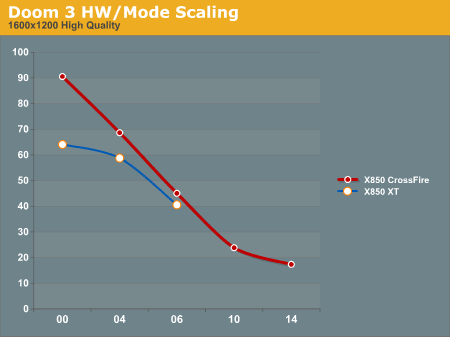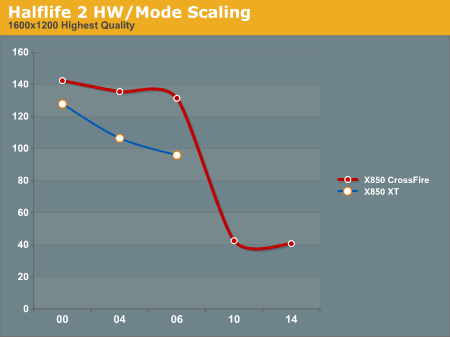ATI's X8xx CrossFire Graphics Arrive
by Derek Wilson on September 26, 2005 1:00 PM EST- Posted in
- GPUs
Mode and Hardware Scaling
There are two scaling factors we want to pay attention to here. First, we will be looking at how CrossFire scales with AA mode. As 8x and 10x share the same performance numbers (as do 12x and 14x), we will be looking at: no AA, 4xAA, 6xAA, 10xAA, 12xAA modes. We will be able to see just how steeply Super AA modes drop off in this test.We will also be looking at single card performance. It will be important to compare these numbers to the Super AA numbers, as each card in Crossfire mode should ideally be able to render the entire scene at single card speeds. Any difference between the Super AA modes and a single card running at either 4x or 6x AA account for the overhead of the communication system and compositing engine. The performance drop in these modes is more pronounced than in the other modes, as each card needs to render the entire scene at full frame rate. Any latency or bandwidth limitations will show up more easily here.
Our graphs show frames per second on the y-axis and AA mode across the x-axis.

Doom 3 shows a good performance increase due to CrossFire at standard AA settings. Both the single card and CrossFire setup are similarly GPU limited as AA increases. The drop from 4xAA on a single card to 10xAA on CrossFire is nearly 50%.
When we take a look at Half-Life 2, we see that a single card is fairly GPU limited with increasing AA while CrossFire handles it well. Going from single card AA modes to CrossFire Super AA modes shows more than a 50% drop in performance. This is likely due to the fact that as framerate increases, the impact of latency and bandwidth restrictions on transferring fully antialiased scenes from the slave to the master is proportionally greater.

Here's a look at how going from a single to a two card configuration scales under NVIDIA and ATI hardware under the games we tested.
| Multi GPU % Performance Improvement (16x12 noAA) | |||
| Doom 3 | Battlefield 2 | Half-Life 2 | |
| CrossFire | 41.3 | 53.8 | 15.8 |
| SLI | 34.0 | 89.3 | 22.2 |
| Multi GPU % Performance Improvement (16x12 4xAA) | |||
| Doom 3 | Battlefield 2 | Half-Life 2 | |
| CrossFire | 69.2 | 63.6 | 35.5 |
| SLI | 81.3 | 89.3 | 68.8 |
While Crossfire performs reasonably well without AA, the 4xAA modes show that SLI provides better scaling. More importantly, though, the lack of support for higher resolutions - as well as 1600x1200 at higher refresh rates - becomes a serious limitation of Crossfire. 7800 GTX SLI running at 2048x1536 has no competition from any ATI configuration for the time being.










76 Comments
View All Comments
Pete - Monday, September 26, 2005 - link
Dangher, you won't find an article to support your claims. It was speculated (in many a forum and possibly by Josh at Penstarsys) that AFR could double XF's single-link TDMS' refresh rate or resolution by interleaving frames, but that's been ruled out, as apparently the RAMDAC must run at the TDMS engine's rate, and the CE doesn't have buffer enough to support RAMDAC refresh rates indpendent of the TDMS engine.So, I'd be surprised if you do.
And Derek won't be sued for libel unless he intentionally published false info. I'm sure much of his info came from ATI themselves, as well as hands-on experience (which shows a 16x12@60Hz limit across the review-site board).
JarredWalton - Monday, September 26, 2005 - link
I think there has been speculation about what could be done with additional low-level hardware and driver tweaks. For now, X8xx Crossfire does not appear to have any support for anything beyond 1600x1200@60 Hz. That's terrible, in my opinion. I have a 9 year old 21" CRT that can run 1600x1200@75Hz. Anyone that has the money to buy Crossfire is highly likely to have a better monitor than that. Meanwhile, my 2405FPW may only run at 60Hz, but lack of 1920x1200 output makes X850 Crossfire a definite no.My only hope is that ATI has spent more effort on R520 Crossfire and will manage to support at least 2048x1536@85 Hz. That's about where top quality CRTs max out, and there are far more 22" CRT owners than Apple 30" Cinema Display owners. :|
Fluppeteer - Tuesday, September 27, 2005 - link
I'm surprised that any single-link resolution isn't possible (so a digitally driven2405FPW ought to work), but it's clear that there's a problem with CRTs. The R520's
dual-link outputs would appear to solve the problem with reasonable headroom, coincidentally supporting dual link monitors.
Dangher's post *could* make sense - by interleaving pixels one could, in theory, take
two single-link images and produce a dual-link one. But the chips aren't really set
up to render like that - it's certainly not one of the announced Crossfire modes.
It would probably also be slower than the existing modes.
AFAIK there's very little intelligence in the CE (or in the SLi combiner) - the
chip not producing output for the relevant bit of screen just outputs black, and
the CE/SLi combiner just ORs the values from the two heads together. There's a bit
of genlock involved and the DVI receiver and transmitter, but the amount of actual
logic is tiny. Unless I'm wrong about how it works, but I don't see the need for
more (except for the multi-card antialiasing, which presumably needs some blending
support - I was a bit surprised that nVidia could retrofit this for that reason).
You could do all kinds of clever things if the SLi bridge/Crossfire connection
was actually a general-purpose high bandwidth link between the two cards, but to
the best of my knowledge, it's not: it's video only, so you're limited to what
the cards can drive on their digital video outputs when it comes to displaying
the result, and uneven splitting won't help you - it's the peak rate of output
which matters, not the average throughput.
On the plus side, with enough supersampling 1280x1024 on a CRT might not look
much worse than 1600x1200 with less...
Fluppeteer - Thursday, September 29, 2005 - link
I've belatedly picked up on something. Sorry if I'm being slow, but to confirm:The multi-card supersampling mode... is the frame from the secondary card sent
over the PCI-e bus, rather than over the Crossfire link? If so, this would
explain a large performance drop as it's implemented, but also explain how
nVidia could implement the equivalent mode without having built blending
directly into their SLi combiner in the first place (and also suggest that
the Crossfire combiner doesn't need to be clever enough to blend). It might
alse explain why nVidia's implementation coincided with a bridgeless SLi
capability (once you've done the work in the driver...)
If they *do* this, there's no reason for it to be limited to 1600x1200 (or
single-link bandwidth), other than that the PCI-e bus will be limiting the
refresh at some point.
Just wondering, and curious whether I'm imagining it.
--
Fluppeteer
DerekWilson - Monday, September 26, 2005 - link
:-)I don't get offended easily. I'm certainly the first person who wants to know if I got something wrong. At the same time, it is my responsibility to get across the clearest way possible, so I'm also concerned when it doesn't seem that I have communicated the facts clearly enough.
Derek Wilson
erinlegault - Monday, September 26, 2005 - link
All of the reviews I've been reading today on Crossfire have been saying the same thing. Can you tell us how they are all wrong?Leper Messiah - Monday, September 26, 2005 - link
The last table on the last page is missing, there's just a [table] tag.DerekWilson - Monday, September 26, 2005 - link
sorry again ... I'll drop in in a second.Leper Messiah - Monday, September 26, 2005 - link
If this had been released 6 months ago, it would be good. Right now with one 7800GTX beating it in some benchies, and SLi GTs and GTX raping it, this just doesn't cut it. Hopefully ATi has something amazing with the R520, otherwise they are heading back to the days of pre-R300.sxr7171 - Monday, September 26, 2005 - link
Okay, I don't get this. I'm running a 24" widescreen monitor at 1920x1200@60HZ using single link DVI. The limit for single-link DVI at 60HZ is said to be 2.6 megapixels which is quite a bit higher than 1600x1200.